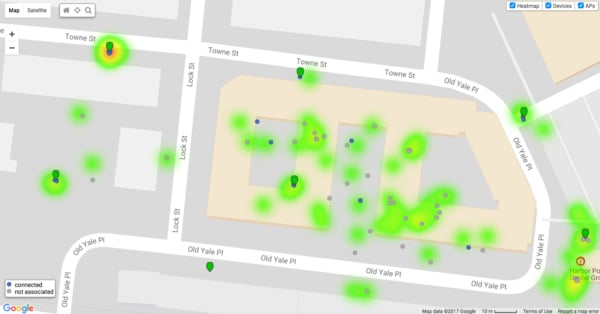Boosting Customer Engagement With Location Analytics
 Using new technologies to solve the age-old problem of customer engagement
Using new technologies to solve the age-old problem of customer engagementThe competition between brick-and-mortar shops and ecommerce retailers has never been fiercer. And to many observers, leading ecommerce companies like Amazon seem to have the upper hand: according to PwC, online retail sales grew over 10% in 2016, compared to just 1.4% for brick-and-mortar retail. But traditional retailers have a trick up their sleeve: experiential shopping, which turns physical shopping into an engaging experience that no online retailer can come close to emulating.
One of the best ways brick-and-mortar retailers can deliver a personalized, high-impact customer experience is through location analytics technologies. Retailers now have the power to combine Bluetooth Low Energy (BLE) and the Wi-Fi signals emanating from shoppers’ smartphones to understand customer behavior patterns, like where they are in the store and how long they’ve been there, and shape the shopping experience around these customers’ needs.
Here are just a few ways brick-and-mortar retailers can take advantage of location analytics to boost customer engagement.
1. Grab shoppers’ attention at just the right moment.
Remember those old coupon dispensers (affectionately referred to as “Blinkies”) that were in every aisle of most grocery stores in the ‘90s? Location analytics allows retailers of all types, grocery or otherwise, to grab shoppers’ attention just like these coupon dispensers once did.
Retailers that offer free guest Wi-Fi with BLE-enabled access points can push relevant display ads, notifications, and targeted coupons to customers’ smartphones at the right place and at the right time. For example, if a shopper has been lingering in the lipstick aisle of a beauty store, the retailer can push a “50% off the second lipstick” promotional coupon right to her smartphone, thereby increasing the likelihood of conversion.
It’s a win-win: the customer feels like she’s gotten something relevant and valuable, while the retailer can make more sales. Location analytics makes this all possible.
2. Optimize store layout in line with foot traffic trends.
Most retailers pay close attention to sales per square foot as a metric for how well they’re doing. Ensuring the layout of a store conforms to shoppers’ needs and expectations is key to maximizing this metric. However, for many retailers, store layout has often been more of an art than a science: what “feels right” over what actually is right. Location analytics changes the equation. Now shop owners can know precisely where shoppers are within the store and use this knowledge to put merchandise or in-store displays in the right place to maximize product exploration and purchase likelihood.
It all happens like magic: shoppers’ smartphones that have Wi-Fi and Bluetooth enabled automatically send out probes and beacons that can communicate with access points and Bluetooth sensors. Through various mechanisms, these sensors can triangulate shoppers’ locations within the store. Over time, store owners can see a visual map of where customers are (and aren’t) going within the store.

A location heat map, with foot traffic and Wi-Fi access points mapped.
Interestingly, grocery stores have designed their store layouts in a very specific way to increase how long shoppers spend in-store, as well as average basket size. Location analytics lets businesses of all types do this in a data-driven manner. As an example, a home improvement store like Orchard Supply Hardware (OSH) could glean information from location heat maps that customers don’t linger near the paint section for long. The store owner could then decide to locate the paint near a more heavily trafficked area — say, the hardware area — or to increase the visibility of signage pointing to the paint aisle.
3. Always put the best message out there.
The era of mass advertising has largely given way to more targeted, personalized messaging appropriate for consumers at different stages of their buying journey and with different needs. It’s imperative that retailers adapt to this new reality — that they learn more about their customers in order to specifically tailor messages for their audiences. Location analytics can help by tracking customer behavior both inside and outside the store.
In-store, location-based data can be used to track how often customers visit (and return) to stores, and for how long. Imagine how valuable it would be to know not only when people visit — information that’s available simply through observation — but also why they’re coming back (is a new promotion working?), how often they come back (are these frequent shoppers or sporadic visitors?) and how long they linger inside the store. Once customers connect to the store’s Wi-Fi network, stores can track visitors each time they come back. This information can be linked to loyalty programs to provide even deeper insight into customers’ behavior.
Even when customers aren’t in the store, companies that utilize Facebook login as an authentication tool can get a host of anonymized customer demographic information, such as age, gender, education, workplace, and more. This information can automatically be aggregated and organized to give store owners valuable insight into who their customers are.
Conclusion
Brick-and-mortar stores can and should leverage every resource possible to create personalized customer experiences. Location analytics can help physical retailers learn more about their customers, just like their online counterparts, thereby making the physical shopping experience more engaging and high-touch.
All Cisco Meraki access points come with integrated BLE radios. Combined with the location analytics capabilities built into the Meraki dashboard, retailers that deploy Meraki in-store can learn more about their customers and use this knowledge to elevate the shopping experience.
Blog via Meraki. Published with permission